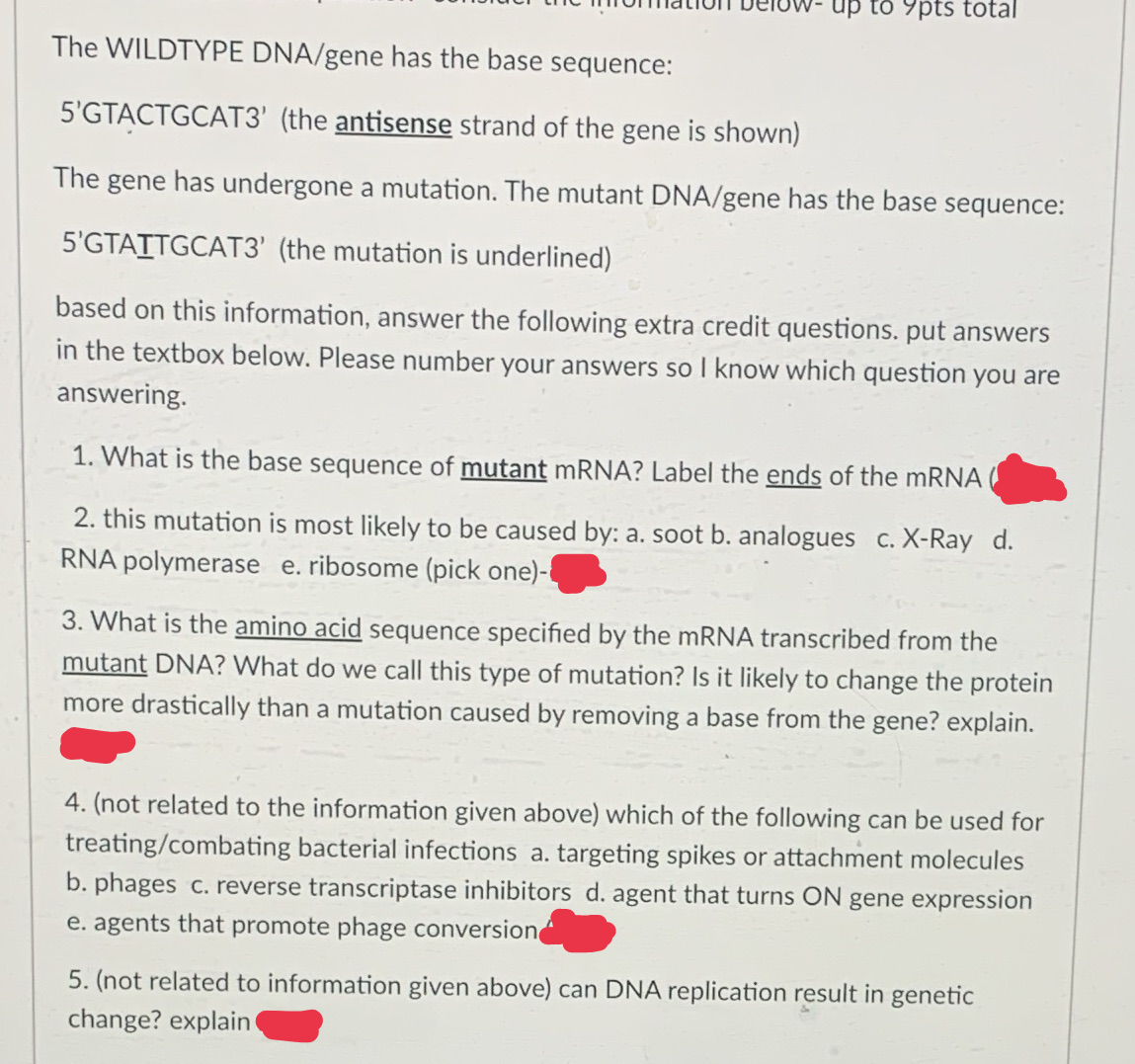up to 9pts total The WILDTYPE DNA/gene has the base sequence: 5'GTACTGCAT3' (the antisense strand of the gene is shown) The gene has undergone a mutation. The mutant DNA/gene has the base sequence: 5'GTAITGCAT3' (the mutation is underlined) based on this information, answer the following extra credit questions. put answers in the textbox below. Please number your answers so I know which question you are answering. 1. What is the base sequence of mutant mRNA? Label the ends of the mRNA 2. this mutation is most likely to be caused by: a. soot b. analogues c. X-Ray d. RNA polymerase e. ribosome (pick one)- 3. What is the amino acid sequence specified by the mRNA transcribed from the mutant DNA? What do we call this type of mutation? Is it likely to change the protein more drastically than a mutation caused by removing a base from the gene? explain. 4. (not related to the information given above) which of the following can be used for treating/combating bacterial infections a. targeting spikes or attachment molecules b. phages c. reverse transcriptase inhibitors d. agent that turns ON gene expression e. agents that promote phage conversion 5. (not related to information given above) can DNA replication result in genetic change? explain
up to 9pts total The WILDTYPE DNA/gene has the base sequence: 5'GTACTGCAT3' (the antisense strand of the gene is shown) The gene has undergone a mutation. The mutant DNA/gene has the base sequence: 5'GTAITGCAT3' (the mutation is underlined) based on this information, answer the following extra credit questions. put answers in the textbox below. Please number your answers so I know which question you are answering. 1. What is the base sequence of mutant mRNA? Label the ends of the mRNA 2. this mutation is most likely to be caused by: a. soot b. analogues c. X-Ray d. RNA polymerase e. ribosome (pick one)- 3. What is the amino acid sequence specified by the mRNA transcribed from the mutant DNA? What do we call this type of mutation? Is it likely to change the protein more drastically than a mutation caused by removing a base from the gene? explain. 4. (not related to the information given above) which of the following can be used for treating/combating bacterial infections a. targeting spikes or attachment molecules b. phages c. reverse transcriptase inhibitors d. agent that turns ON gene expression e. agents that promote phage conversion 5. (not related to information given above) can DNA replication result in genetic change? explain
Human Anatomy & Physiology (11th Edition)
11th Edition
ISBN:9780134580999
Author:Elaine N. Marieb, Katja N. Hoehn
Publisher:Elaine N. Marieb, Katja N. Hoehn
Chapter1: The Human Body: An Orientation
Section: Chapter Questions
Problem 1RQ: The correct sequence of levels forming the structural hierarchy is A. (a) organ, organ system,...
Related questions
Question
Answer for 1 ,2,and 3
asap

Transcribed Image Text:up to 9pts total
The WILDTYPE DNA/gene has the base sequence:
5'GTACTGCAT3' (the antisense strand of the gene is shown)
The gene has undergone a mutation. The mutant DNA/gene has the base sequence:
5'GTAITGCAT3' (the mutation is underlined)
based on this information, answer the following extra credit questions. put answers
in the textbox below. Please number your answers so I know which question you are
answering.
1. What is the base sequence of mutant mRNA? Label the ends of the mRNA
2. this mutation is most likely to be caused by: a. soot b. analogues c. X-Ray d.
RNA polymerase e. ribosome (pick one)-
3. What is the amino acid sequence specified by the mRNA transcribed from the
mutant DNA? What do we call this type of mutation? Is it likely to change the protein
more drastically than a mutation caused by removing a base from the gene? explain.
4. (not related to the information given above) which of the following can be used for
treating/combating bacterial infections a. targeting spikes or attachment molecules
b. phages c. reverse transcriptase inhibitors d. agent that turns ON gene expression
e. agents that promote phage conversion
5. (not related to information given above) can DNA replication result in genetic
change? explain
Expert Solution
This question has been solved!
Explore an expertly crafted, step-by-step solution for a thorough understanding of key concepts.
Step by step
Solved in 3 steps with 2 images

Knowledge Booster
Learn more about
Need a deep-dive on the concept behind this application? Look no further. Learn more about this topic, biology and related others by exploring similar questions and additional content below.Recommended textbooks for you

Human Anatomy & Physiology (11th Edition)
Biology
ISBN:
9780134580999
Author:
Elaine N. Marieb, Katja N. Hoehn
Publisher:
PEARSON

Biology 2e
Biology
ISBN:
9781947172517
Author:
Matthew Douglas, Jung Choi, Mary Ann Clark
Publisher:
OpenStax

Anatomy & Physiology
Biology
ISBN:
9781259398629
Author:
McKinley, Michael P., O'loughlin, Valerie Dean, Bidle, Theresa Stouter
Publisher:
Mcgraw Hill Education,

Human Anatomy & Physiology (11th Edition)
Biology
ISBN:
9780134580999
Author:
Elaine N. Marieb, Katja N. Hoehn
Publisher:
PEARSON

Biology 2e
Biology
ISBN:
9781947172517
Author:
Matthew Douglas, Jung Choi, Mary Ann Clark
Publisher:
OpenStax

Anatomy & Physiology
Biology
ISBN:
9781259398629
Author:
McKinley, Michael P., O'loughlin, Valerie Dean, Bidle, Theresa Stouter
Publisher:
Mcgraw Hill Education,

Molecular Biology of the Cell (Sixth Edition)
Biology
ISBN:
9780815344322
Author:
Bruce Alberts, Alexander D. Johnson, Julian Lewis, David Morgan, Martin Raff, Keith Roberts, Peter Walter
Publisher:
W. W. Norton & Company

Laboratory Manual For Human Anatomy & Physiology
Biology
ISBN:
9781260159363
Author:
Martin, Terry R., Prentice-craver, Cynthia
Publisher:
McGraw-Hill Publishing Co.

Inquiry Into Life (16th Edition)
Biology
ISBN:
9781260231700
Author:
Sylvia S. Mader, Michael Windelspecht
Publisher:
McGraw Hill Education